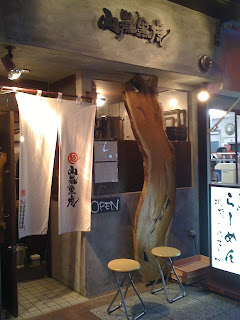In comes Aji no Kura, 味の蔵, The Taste Shack.
Aji no Kura is a recent restaurant being heavily, I mean heavily, advertised on Tabelog. Every time you search for Ramen in Hokkaido, this restaurant pops up in the sponsored area. It's also seemingly popular, usually a few people out the door waiting, and it mantains a 3.5/5 rating online. If anything, the first reason to the shop's popularity just comes from their hours.
Open 24/7.
Ramen tends to be well associated with the late night dwellers of Japan, the drunk masses hungry loners looking to fill up after their alcohol fill up, and a 24 hour spot in downtown drinking central Susukino pretty much can't be beat.
There's a couple issues pushing folks back however. The initial one is that this shop isn't actually Sapporo-grounded at all, it began in Shinjuku, a ward of Tokyo, and to many Sapporo ramen purists, this is a negative characteristic. Can we truly call it Sapporo ramen if it didn't start in Sapporo?
Well... why not? With modern technology allowing transportation of all sorts of agriculture, do the lines of what is genuinely Sapporo blend? Restaurants like this somewhat suggest that question.
Perhaps the reason the reason it doesn't scream Sapporo Ramen is because the menu attempts to replicate ramen from all over Japan, rather than focusing on one style. It feels like a shop importing ideas to Sapporo, rather than making new ones.
Well, we've heard the shop background so far. It's open all day and night, and has a pretty remarkable location.
How about the goods?

Aji no Kura is famous for their Pork Bone broth, a broth apparently simmered for more than 12 hours to extract as much rich, milky flavor as possible. They are not, however, famous for Miso, or really any particular style infact.
This shows quickly in the above miso dish. It's composed much like a Pork Bone soup, but the miso is put largely, if not completely on the back burner.
Furthermore, although you're able to pick one of two noodles, both of which are made by the company, they're both thin and fairly un-curly.
So on a basis, it doesn't really even share the miso characteristics Sapporo folk love. No thick noodles, no powerful miso flavor. It reminds me of Kyushu Ramen to be honest. Which is not a bad thing at all.
In fact the food is pretty dang good. As a Pork Bone soup, it's very tasty, a good balance of rich and light. Some garlic oil drizzled on top adds good complexity and character, and the noodles pair up well with the soup's characteristics (though I thought they were soft).
The shop also provides a laundry list of toppings you can freely add, including crushed by yourself garlic, stewed spicy vegetables, and pickled ginger, among others. This can at times be overwhelming, but at the same time, fun to customize a bowl.
If drunk at 3 am, this might be the closest option you have for that late night ramen fix. And you certainly wouldn't be disappointed.
View Larger Map
Aji no Kura
Open 24 hours a day, 7 days a week.
Links:
http://www.ramen-ajinokura.com/
http://r.tabelog.com/hokkaido/A0101/A010103/1026114/






































